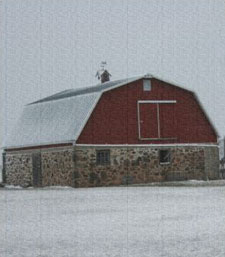A prospective client recently posted this question about block foundations:
 “Our family farm was started around 1850. During this time there were 12-14 barns and 1 house. Most barns deteriorated due to bad roofing. But we’re talking about stuff that lasted 100 years and some longer. We still have 4 barns left and the house which are all sitting on stacked 36″x36x12″ thick hand cut stone. My question is im getting ready to build a new building so is this type setup better than a standard pole barn? If so why does everyone then do pole barns? I could do a block foundation vs rock if this is a better way to go. The equipment building will board and batten with concrete floor and be 60×40 or so in size. Im looking for longevity and want to avoid rotting post.
“Our family farm was started around 1850. During this time there were 12-14 barns and 1 house. Most barns deteriorated due to bad roofing. But we’re talking about stuff that lasted 100 years and some longer. We still have 4 barns left and the house which are all sitting on stacked 36″x36x12″ thick hand cut stone. My question is im getting ready to build a new building so is this type setup better than a standard pole barn? If so why does everyone then do pole barns? I could do a block foundation vs rock if this is a better way to go. The equipment building will board and batten with concrete floor and be 60×40 or so in size. Im looking for longevity and want to avoid rotting post.
Thoughts?”
100+ years ago, a reliable pressure treating process did not exist which would preserve wood (timbers/lumber) embedded in the ground. As a result, farm buildings were constructed similar to what is described. The stone piers were probably adequate in area to prevent buildings from settling. However they would prove no resistance to either frost heave (in areas which have frost issues), or uplift situations. If stone piers were the solution, they would be both Code conforming, as well as used extensively for new construction.
Post frame (pole buildings) have decades of reliable performance. They are the most economical permanent structure which can be built.
Although properly treated timbers will easily outlive any of us alive to read this today, there are many lumber yards selling pressure treated wood which is not designed for structural in ground use. The Building Codes require any wood which will be embedded in the ground, for foundation purposes, to be pressure preservative treated to a UC-4B (UC is Use Class) rating.
Look at the tags on the treated lumber on your next visit to a lumber yard or big box lumber provider. If the tags say UC-3 or UC-4A, they are not designed to be embedded in the ground.
Not convinced UC-4B will last? There are several manufacturers of plastic sleeves, which can be placed over the base of the columns, isolating them entirely from the surrounding soils.
Concrete footings are not inexpensive!
There are tremendous, and in my mind unnecessary, costs involved in pouring concrete footings and properly constructing either a concrete or block foundation to place a building on. There are engineered brackets which are designed to be poured into the top of foundation walls (again, beware – most post base brackets are not designed to withstand the moment loads induced into them by bending columns). Taking an educated guess, they would probably be inadequate with a block foundation, unless the block had adequate rebar and was poured solid with concrete.
Steel wins hands down for durability and longevity
If considerations include cost, being maintenance free and longevity, in my humble opinion board and batten siding is probably not the most effective design solution. I made the error of siding two of my own buildings with cedar siding, and after twenty years of having to solid body stain them – repeatedly, I would never do it again. Painted steel siding is without question going to be the most cost effective and durable design solution.






